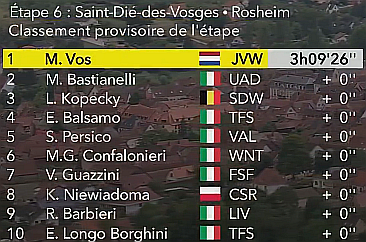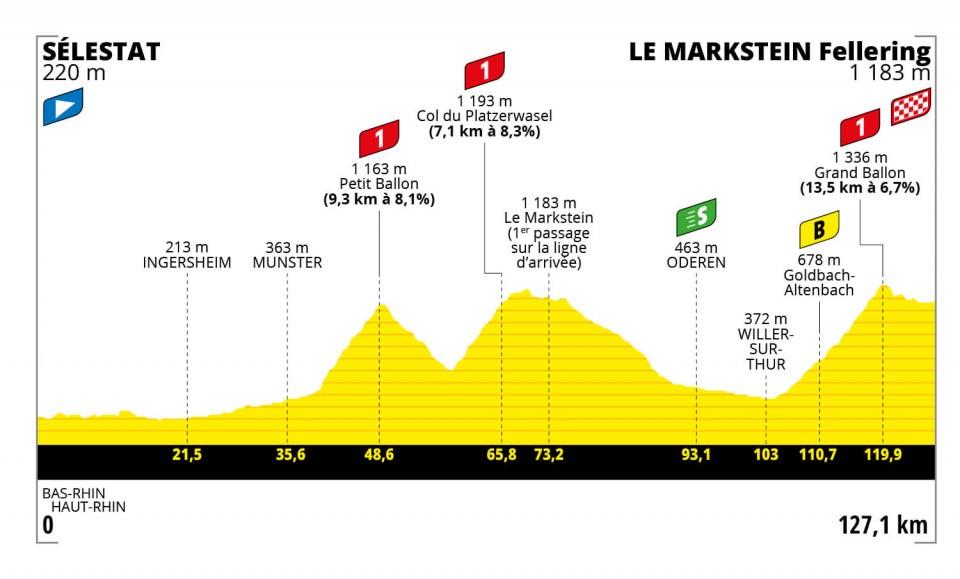Stage 7
Sélestat to Le Markstein, 127.1km
COMMENTARY FROM MARION ROUSSE
A gentle start on the Alsace plain before tackling three of the toughest passes in the Vosges (Petit Ballon, Platzerwasel, Grand Ballon), which come one after another and should establish a very clear hierarchy. Rather than descending again after the final climb, the route will follow the ridge line towards the Markstein, where a great climber will be crowned.
SÉLESTAT AND CYCLING
It was an omission that could not last. Sélestat has never hosted a stage of the Tour, for men or women. Yet the Alsatian city is a land of cycling, served by its network of cycle tracks and its beautiful natural heritage. It is also a regular venue for the Tour d'Alsace (last winner Tim Merlier in 2019). It is also a sports town, twice awarded the national title by the newspaper L'Équipe, in 1959 and 2010. And it inspired lots of prominent sports personalities sulike legendary handball goalkeeper Thierry Omeyer or wimmer Béatrice Hess, a multi-medallist at the Paralympic Games, who started out in Selestat clubs. All that was missing was this cycling consecration...
SIGHTS:
Humanist Library
In the heart of the historic centre of Sélestat, the Museum of the Humanist Library invites you to follow the life of Beatus Rhenanus. A humanist from Sélestat, he bequeathed his exceptional library at his death, one of the richest and most beautiful collections of the time. It consists of 423 volumes, containing 1,287 works and 41 manuscripts in various collections, as well as 33 old manuscripts and 255 autograph letters. This contribution constitutes the "treasure" of the Humanist Library of Sélestat. The library has been listed in the UNESCO Memory of the World Register since 2011. Between 2014 and 2018, it underwent a major renovation operation. Entrusted to Rudy Ricciotti, a world-renowned architect, the architectural project combined the neo-Romanesque style of the former Halle aux Blés with a resolutely modern extension. The latter is made up of a series of 25 columns in Vosges sandstone that play on the effects of transparency and light.
Sainte-Foy Church
Construction: 12th century.
Style: Romanesque
Listing: listed as a historical monument in 1862.
Characteristic: The main portal of the church, dating from the second half of the 12th century, retains all its original sculptures. The portals are adorned with 19th century works. The capitals, made by Irish stonemasons, display Celtic motifs. The exterior statues were executed between the 17th and 19th centuries. The altarpieces and pulpits are Baroque.
History: a first building was erected around 1087 (see crypt). A priory church was built between 1152 and 1190, thanks to donations from Frederick Barbarossa. The new building, built on a basilica plan with a shallow transept, is closer in style to the Lorraine and Burgundy buildings than to the Rhine Romanesque. Managed by the Benedictines and then by the Jesuits, who introduced Baroque elements, it was restored in the 19th century and listed in 1862.
St. George's Church
Construction: 8th to 15th century.
Style: Gothic
Listing: listed as a historical monument in 1848.
Features: Construction of the ornate west tower began in the early 14th century and was completed in 1490. Six bells are housed in the tower, the first of which, known as the "bourdon", is decorated with, among other things, the Sélestat lion. The 60-metre high Gothic bell tower of St. George's Church is one of the first things you see when you arrive in Sélestat.
History: in the 8th century, a Carolingian baptismal chapel was located on the site of the church, as part of an imperial complex built by Charlemagne. Charlemagne came here at Christmas time in 775.
Construction of the church began in the 1220s and continued in several stages until the 15th century. During this period, the original choir was replaced by a much larger sanctuary with numerous windows, 55 of which are still original.
Special features: Because of its size, the parish church of St. George could be mistaken for a cathedral. However, this is not the case, as a cathedral is the seat of a bishopric, which has never been the case in Sélestat.
Witches' Tower
Construction: 1216 to 1299
Listing: listed as a historical monument in 1929.
History: The Witches' Tower is the former Niedertor (lower gate) of the first wall (1216-1230), which is said to have been altered in the late 12th and late 14th centuries. Its present state is quite different from its original appearance. The upper floors were used as a prison, especially in the 17th century, for "witches" before their execution. In 1774, the ground floor housed a gunpowder warehouse and a depot for the equipment of the fortification service.
Characteristic: the first two levels of the tower are original. These levels can be recognised by the corner chains of sandstone or granite with bosses which extend for approximately 10 metres at the corners of the façade facing outwards from the town. Around 1299, the tower was raised by three storeys. It was also at this time that the tower was fitted with defensive elements.
St. Barbara's Arsenal
Built: 1470
History: St Barbara's Arsenal was built around 1470 on the site of the old medieval synagogue. Its primary function was to serve as a warehouse for goods and as a granary for the town. About sixty years later, in 1534, the Magistrate of Sélestat had the first floor converted into an arsenal to replace the Saint-Hilaire Arsenal (listed as a historical monument), which was too small. It was at this time that the building was dedicated to Saint Barbara, patron saint of artillerymen. In the 19th century, the building was used as a warehouse for storing wheat, tobacco and hops before being transformed into a theatre in 1899. Municipal architect Jean-Jacques-Alexandre Stamm was responsible for the work.
LE MARKSTEIN AND CYCLING
This winter sports resort forms a cross-country skiing complex with the Breitfirst site and the high Nordic toll road, which also links it to the Grand Ballon. It was a stage of the Ski World Cup in 1983 and 1987 and twice saw legendary Swedish slalom skier Ingemar Stenmark win. In the 2014 men's Tour, Tony Martin staged a long breakaway between Gérardmer and Mulhouse and came first at the summit. In 2019, it was Belgian Tim Wellens who led at the top. Le Markstein has also hosted three finishes of the Tour d'Alsace.
TO EAT:
Bäckeoffe
Stew of potatoes and three meats marinated in Alsatian white wine and cooked in a terrine for 24 hours (literally means "bread oven"). The Alsatian Lutheran Protestant denomination respects the tradition of the Sabbath from the Old Testament of the Bible. Baeckeoffe is therefore a dish inspired by hamin, a traditional dish of Jewish Sabbath cooking.










